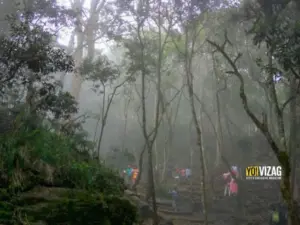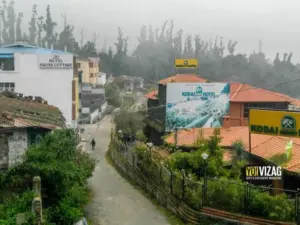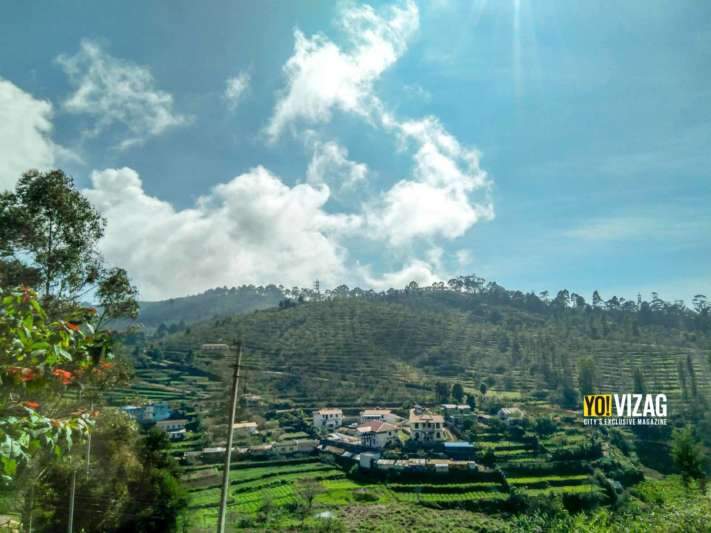Tamil Nadu’s best-kept secret is wafted in scents of pine and eucalyptus in a town which is India’s only American hill station. Join Alisha Roy as she inks the trip to Kodaikanal, a timeless place that the modern traveller cannot tamper with.
 The long and winding Perumal Malai Road, a three hours drive from Madurai, leads to the pine-clad hills of Kodaikanal. Found in 1845 by American missionaries, this off-the-grid retreat has just a few thousand inhabitants. Although the indigenous influence is significant here, this region’s culture is ripe with American architecture, in a country predominant in colonial-British hill stations. Typically two stories high with slanting roofs and chimneys, bungalows here are much like their American predecessors. With awe-inspiring backdrops of cliffs and waterfalls, this quiet hill town is dotted with buildings still known by their colonial names like ‘Baynes’, ‘Sunny Side’ and ‘Shelton’; overlooking luscious hues of green.
The long and winding Perumal Malai Road, a three hours drive from Madurai, leads to the pine-clad hills of Kodaikanal. Found in 1845 by American missionaries, this off-the-grid retreat has just a few thousand inhabitants. Although the indigenous influence is significant here, this region’s culture is ripe with American architecture, in a country predominant in colonial-British hill stations. Typically two stories high with slanting roofs and chimneys, bungalows here are much like their American predecessors. With awe-inspiring backdrops of cliffs and waterfalls, this quiet hill town is dotted with buildings still known by their colonial names like ‘Baynes’, ‘Sunny Side’ and ‘Shelton’; overlooking luscious hues of green.
The stay
 Kodaikanal is not entirely remote and has its share of tourists, but never enough to compromise the stay. There are dozens of hospitable guest houses and inns nestled in the serenity of this lake town. Luxurious BnBs are often overbooked in summers. Historically, it attracted visitors looking for an escape from the stifling heat of Indian summers; a trend which continues even now. Chilly winters with temperatures below 20 degrees are the best time to visit. During the rainy months from June to August, the sun barely cracks the horizon.
Kodaikanal is not entirely remote and has its share of tourists, but never enough to compromise the stay. There are dozens of hospitable guest houses and inns nestled in the serenity of this lake town. Luxurious BnBs are often overbooked in summers. Historically, it attracted visitors looking for an escape from the stifling heat of Indian summers; a trend which continues even now. Chilly winters with temperatures below 20 degrees are the best time to visit. During the rainy months from June to August, the sun barely cracks the horizon.
On the beaten track
Kodaikanal is meant for random wandering with an unmistakable this-is-the-place-to-be feeling. Hire a boat to explore the charming Kodai Lake or walk the five-kilometre perimeter amid a crescendo of chirping sparrows and clopping sounds of horses’ hooves. Inject colour in the cobbled path by stopping at Byrant Park which is known for its botanical wonders. Rare flowers in the park’s ‘Flower Show’ attract international visitors. The park opens up into colourful bazaars which sell woollen clothes, essential oils or an excuse to warm the hands around a cup of hot cocoa.
Eco-centric
Kodai is not just another tourist cool spot ruined by pollution, as any traveller in India would expect it to be. It is cleaner and less polluted with sidewalks void of tourist detritus like plastic bags and food litter. The local government recorded high levels of mercury in the lakes here and as a countermeasure, it banned plastic bags. Vendors and visitors followed suit by using paper bags instead.
Hidden treats
taSimplicity and freshness are the key ingredients in this hill town’s menu. A short walk down from the lake leads to PT Road which is the centre of it all. Chalet-like restaurants humble the palette with the simple goodness of buttered bread and jam, steamed momos and brick oven pizzas. Narrow lanes go along roadside stalls; each offering tempting fares like homemade chocolates and hot brews sourced from the Palani hills nearby. Some fruits in Kodai’s markets can be found elsewhere, but the freshness and variety here are unparalleled.
Picture book town
Every path in this countryside presents itself with a different atmosphere. One such scenic lookout is the beauty of the 100-year-old Pine Forest. The cool mountain air in this wooded land clears the mind and refreshes the creative soul. The forest transforms into a muse for artists and writers, with its breathtaking views of treetops that disappear in the mist.
Not far from the forest, muddy tracks negotiate for road space as vehicles swerve through hairpin bends. The legendary Guna Caves appear unannounced around one such bend. The caves owe their fame to the Tamil cult film ‘Guna’ which was shot here. But the real crowd-pleaser is the local guide’s stories that justify the restricted entry to the caves. The trip is incomplete without a quick stop at the popular locale of Silent Valley, which juts out from the edge of a cliff. A northern trail up the Berijam Road from this viewpoint ends refreshingly in the pooling water under Fairy Falls which is one of Kodai’s many waterfalls.
Parallel lives
It appears that there are two lifestyles that unfold in this verdant hilltop. One is a traditional way of life preserved with the locals who cultivate small plots of terraced lands. Contrarily, prominent elite often visits their lavish cottages here, coming and going as they please; just like the mist passing through the quaint slopes of Kodaikanal.
Retaining a timeless charm, this is a destination that one must visit not as a tourist, but as a surveyor of an idyllic hill station.










Discussion about this post